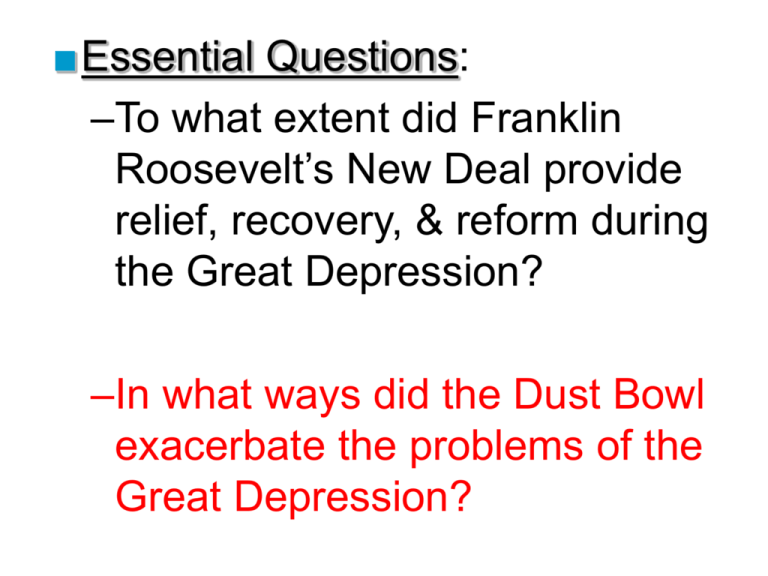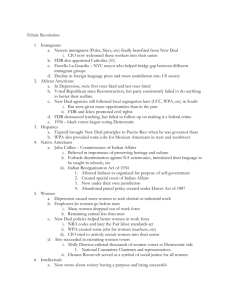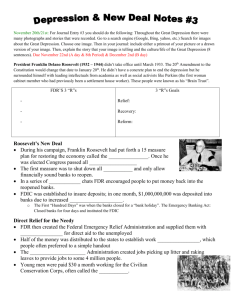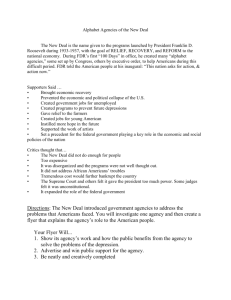FDR & the New Deal
advertisement

■Essential Questions: –To what extent did Franklin Roosevelt’s New Deal provide relief, recovery, & reform during the Great Depression? –In what ways did the Dust Bowl exacerbate the problems of the Great Depression? Franklin Roosevelt & the First New Deal (1933-1935) The Dust Bowl (1931-1939) worsened the “Okies” & “Arkies” Areas Affected by the Dust Bowl drought effects of the Depression The Election of 1932 ■The depression made Hoover the victim, but Franklin Roosevelt emerged as the “savior”: –In the 1932 election, FDR was able to unite the rural & urban factions of the Democratic party & won a landslide victory –FDR appealed to Protestants & Catholics, farmers & workers, native-born & immigrants “I pledge you—I pledge myself to a new deal for the American people.” The Hundred Days ■When FDR took over in 1933, the FDR for “broad power of U.S.asked economy wasexecutive on the brink that would be given to me if we were in collapse: fact invaded by a foreign foe.” –Unemployment was at 25% –38 states had total bank failure ■FDR requested from Congress broad executive power to begin his “New Deal” program of economic relief, recovery & reform “Let me assert my firm belief that the only thing we have to fear is fear itself; nameless, unreasoning, unjustified terror which paralyzes needed efforts to convert retreat into advance.” Public PublicRelations Relations:Efforts: EleanorFDR’s Roosevelt’s Firesidetravels Chats The Hundred Days st hundred Banks were regulated (notdays, nationalized); ■In his 1 FDR Now, the FDIC insures the economic system was reformed st began his 1 New Deal (1934-35) deposits up to $100,000 (not drastically changed) ■FDR’s 1st order of business was Emergency Banking Act of 1933 to restore confidence in banking: –Declared a 4-day bank holiday: closed or funded weak banks & opened new gov’t-aided banks –Glass-Steagall Act created the FDIC which guaranteed all bank deposits over $5,000 “Capitalism was saved in eight days” The Hundred Days ■The greatest success of the First New Deal was its ability to offer relief to unemployed citizens via the Reconstruction Finance Corps –Modest relief checks were doled to 15% of Americans –Federal Emergency Relief Act (FERA) pumped $500 million into state welfare programs The Hundred Days ■Relief efforts of the First New Deal created more “alphabet agencies” –Civilian Conservation Corps (CCC) employed urban men –Civilian Works Admin (CWA) hired 4 million men & women –Agricultural Adjustment Admin (AAA) subsidized farmers CCC workers paved roads, planted trees, built bridges CWA Creating drainage system for an airfield Dredging a lake AAA Percentage of American Families Accepting Government Relief in 1933 The Hundred Days ■The National Industrial Recovery Act (NIRA) was the 1st attempt at economic recovery: –Created the National Recovery Admin (NRA) set max hours & minimum wages for workers & stimulated industry by fixing prices & setting production limits Additional attempts to stimulate the economy Works include–Created taking the the U.S. Public off the gold standard & ending prohibition amendment) Admin (PWA)(21 tostbuild public roads, bridges, & buildings National Recovery Administration The NRA ended up being too bureaucratic; business cooperation gave way to self-interest & greed The Hundred Days ■Some of FDR’s First New Deal focused on long-term reforms –Tennessee Valley Authority (TVA) created dams in 7 states to provide cheap hydroelectric power & create jobs –Securities & Exchange Commission (SEC) to regulate the stock market & prevent another stock market crash The Tennessee Valley Authority Critics claimed the TVA was too socialistic; Competing electric companies attacked the TVA for selling cheaper electricity & eliminating competition The Hundred Days ■The 1st hundred days of FDR’s administration were temporary solutions to solve problems, but… ■…psychologically, Americans believed that FDR was actively responding to the Depression The Hundred Days “The whole country is with him, just so he the hand an irondown dictator does“Even something. If heofburned the is in preference to a and paralytic stroke” capitol we would cheer say ‘well, we —Alf (Repub nominee in 1936) at least gotLandon a fire started anyhow.’” —Will Rogers Franklin Roosevelt & the Second New Deal (1935-1938) Criticism of the First New Deal ■The failure of the New Deal to end the depression led to growing frustration among Americans –From 1933-1934, the New Deal focused in immediate problems & did very little to help unskilled workers & sharecroppers –In 1935, FDR shifted approach from economic relief to reform Challenges to FDR ■By 1935, signs of discontent with the New Deal were evidenced as 3 critics gained national attention: –Father Charles Coughlin called for nationalizing U.S. banks; used anti-Semitism in radio sermons –Francis Townsend appealed to the elderly with a $200/mo payment plan to anyone over 60 in order to stimulate the economy Father Charles Coughlin Dr. Francis Townsend Challenges to FDR ■Louisiana Senator Huey Long proposed his Share the Wealth plan to: –Take from the rich—a 100% tax on all personal income over $1 million –Give to the poor—give every American $2,500 per year ButHow whenmany they've got men ever Huey Long everything on God's loving went to a barbecue & Now, how are you earth thatwould they can eat & they let one man going to feed the can wear & they can live in, & take off the table balance of the people? all that their children can live in what's intended for What's Morgan & & wear & eat, & all of their 9/10th of the people to Baruch & Rockefeller children's eat? children can use, then The only way & Mellon going to do& we've gotyou'll to call Mr. Morgan ever be able to with all that grub? They Mr. Mellon and Mr. Rockefeller feed the balance of the can't eat it, they can't back say: “Come back here, Hueyand Long threatened to run people is to make that rd wear the clothes, they put back on this table as athat 3 stuff Party candidate but man come back & can't live in the houses. here you tookin away from was that assassinated 1935 bring back some of here thatthat yougrub don'tthat need. Leave he ain't something else for the got no business with! American people to consume.” “The Kingfish” Challenges to FDR ■The popularity of these opposition “Boys—this is our hour. get voices showed theWe’ve needgot fortothe everything we want…now or never.” New Deal—RFC to do more to help head Harry Hopkins ■In the 1934 mid-term elections, the Democrats increased their control of Congress & initiated a series of programs called the Second New Deal (1935-38) The Second New Deal ■The 1st act of the 2nd New Deal was WPA helped but never employed enough Works (WPA), the peopleProgress to stimulateAdmin consumer purchase most comprehensive, direct-bearable power—it made the Depression assistance program of the New Deal –The national gov’t hired 10 million Americans in an attempt to stimulate the economy –WPA created building projects, funded artists, & pumped $10 billion into the economy WPAcared Public Work Project WPA less about what got done as long as work was done: built hospitals, schools, airport fields… but also moved leaf piles & dug ditches WPA Initiatives WPA Health Initiatives WPA Health Initiatives WPA Arts Project WPA Community Murals Construction of the Dam by William Gropper Kansas City from Politics, Farming, & the Law by Thomas Hart Benton, 1936 WPA Music Projects WPA Theater Projects WPA Writers Projects WPA Travel Guides WPA Oral History Projects: Interviews with former slaves Social Security ■Social Security Act (1935) was the 1st U.S. welfare program for the aged, disabled, & unemployed –Old-age pensions to be funded by employers & workers –Unemployment compensation to begin in 1942 funded nat’l taxes but administered by states –Welfare payments for the blind, handicapped, & needy children ■Liberal critics argued that SS did not do enough ■Conservative critics argued that SS violated individualism & self-reliance ■Social Security created America’s 1st welfare program to help individuals Labor Legislation ■Wagner Act (1935) created the Nat’l Labor Relations Board to oversee labor-management affairs –Mandated management The “Magna Carta” for labor to negotiate with unions regarding 40 hours pay, hours, conditions if majority per week 40¢ per hour of workers vote for a union ■Fair Labor Standards Act (1938) created 1st minimum wage & maximum hour laws (aimed at helping non-unionized workers) Success of the New Deal Programs? The gov’t assumed For the 1st time, the Conclusions gov’t used Keynesian responsibility for the ■The New Deal was of 3 healthmade of the up nation's economics (deficit economy&&reform citizens spending gov’t recovery, parts:&relief, spending to stimulate The New Deal signaled –New Deal was most successful the economy) the beginning of the in providing immediate relief to welfare state ease economic suffering –The New Deal did not bring economic recovery or an end to the depression –The New Deal brought major reforms that changed America


